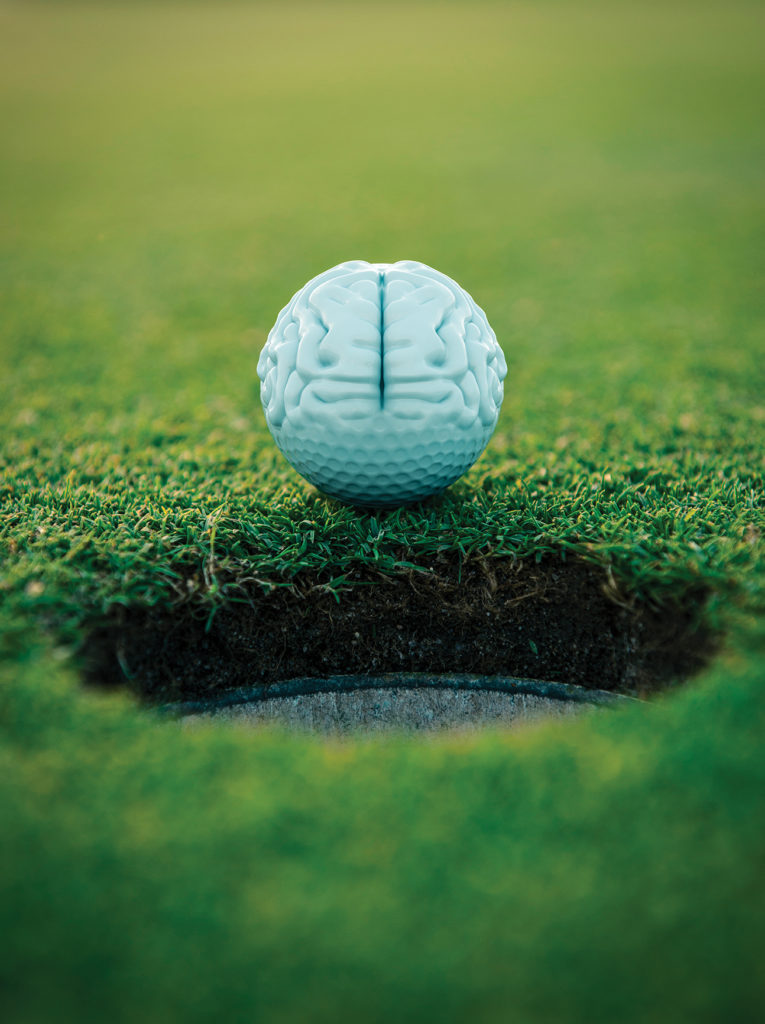“In the 260 minutes it takes to play a round of golf, you spend approximately 5 minutes swinging the golf club. In the remaining 255 minutes, you play golf in your head.” —clinical psychologist and author Dr. Mark Frazier
Success in golf is often unseen. The golfer may not see it, like the slight incline that stops a putt just short of the hole. Or the mental blocks that keep him or her from being the best on the course. Naples psychologist Dr. Marilyn Varcoe has spent the last two decades studying how clinical psychology and golf intertwine. Relying on her experience and scientific studies from Arizona State University and Penn State University researchers, she published Golf Smart: 7 Secrets to Master the Mind Game of Golf. Here we’ve compiled an overview of her research, using segments from Golf Smart and her presentations on the subject. Read on—it may yield just the mental edge you need to take your game to another level. Ü
Goal setting
Before even picking up a club, ask yourself three questions:
What is the outcome goal of my golf game?
What would I like to change?
What would make me more satisfied with my golf game?
Research has proven that clearly defined and measurable goals produce higher levels of performance. You need to find balance between goal difficultly and achievability. Goals that are too easy don’t present a challenge and often result in a mediocre performance. Goals that are too difficult and unrealistic often result in failure. Don’t just set goals, either; determine strategies to achieve them.
For example, try something like this:
Overall goal: Increase the number of putts made from 30 feet by 90 percent.
Strategy: Practice holing four balls each from 10, 20 and 30 feet.
Short-term goal: Improve the percentage of successful putts from 50 to 75 percent.
Target date: Achieve 75 percent of putts from 30 feet by the end of season.
Notice that these goals are written in clearly defined terms. “Ink it, don’t think it,” as the phrase goes. Place them where they can serve as a reminder so that they stay fresh in your mind. Lastly, give yourself feedback. Self-assessment will help you recognize the effectiveness of the goals and help to readjust your strategies, motivation and commitment.
Imagery and mental practice
“Before every shot,” Jack Nicklaus once said, “I go to the movies.”
Nicklaus believes that rehearsing shots in his mind before actually swinging is critical to success. In fact, the Golden Bear has said that hitting a good golf shot is 10 percent swing, 40 percent stance and setup, and 50 percent the mental picture of how the swing should occur.
Imagery involves recalling memories and shaping those pieces into meaningful images. Imagery involves all the senses—visual, kinetic, auditory, tactile and olfactory. The more vivid the memory, the more useful it becomes.
Most golfers frequently take a bucket of balls to the range and try to automate or groove their swing. By doing this, they are strengthening the neural pathways that control the muscles involved. Enhance your game by making this a mental challenge, as well. You can strengthen the same neural pathways by imagining the perfect swing. You are mentally preparing your body for the best performance.
Intensity regulation
Anxiety or nervousness on the course can be one of the biggest hurdles to overcome.
One of the most effective antidotes for anxiety is taking deep, slow breaths to slow down the pace. Try breathing deeply, drawing air into your lower abdominal area and then into your chest, imagining all the tension from your body being drawn into your lungs. Hold for a moment and then exhale, essentially blowing the tension from your body. When done, pause and reflect for a moment on the calming effect.
It’s also a good idea to stretch before beginning your round. When you’re nervous, your muscles tense up. Fred Couples often stretched between shots. He liked his muscles as relaxed as possible. Other ideas:
Smile when you feel tension coming on. After all, it’s hard to tense up when you are smiling. And, remember to enjoy the game. Look forward to pressure situations with a positive attitude and consider the game a challenge to be met.
Plan ahead. Come with a course management plan. Indecisiveness produces anxiety. Making decisions is stressful, so try to pre-plan your game.
Set up stressful shots when practicing on the range. You’ll become more accustomed to playing under pressure.
Stay in the present. Thinking about what might happen (or that bad shot on the last hole) will increase anxiety.
 |
Cognitive strategies
The aforementioned goal setting, imagery or mental practice, and relaxation techniques have been proven to be effective to make you a better golfer. But, most importantly, sports psychologists are aware of golfers’ self-defeating thinking styles and are able to help them acquire more effective thinking habits. Research shows that successful athletes have more effective thinking—they are more positive, more rational and task-focused. Perfectionism, blaming others and beating yourself up all lead to negative results. Golfers need to restructure negative thoughts with the following strategies:
Positive self-talk: Don’t be afraid to compliment yourself. Golfers can use self-talk to correct bad habits, focus attention, build self-confidence and maintain motivation.
Thought stoppage: This technique automatically interrupts the unwanted thoughts by stopping negative self-statements.
Changing negative to positive: Don’t just stop negative thoughts, but follow them up with positive ones.
Countering: Use facts, reason and rational thinking to counter self-defeating thoughts.
Confidence
Confidence is unequivocally the most important ingredient in mastering the mind game of golf. With it, you’ll be able to focus full, clear attention on every shot. Without it, you’ll be continually second-
guessing yourself and inadvertently setting yourself up for failure.
At Arizona State, Dr. Deb Crews worked with a group of tour players, measuring brain activity during the golf stroke using an EKG machine. The results found that confident putting was characterized by a lower level of activity in the brain. Essentially, the play was more automatic and smooth, without the distractions of over-analysis.
Confidence is not something you are born with but rather a learned habit. Ben Hogan built confidence by replaying in his mind his great shots. He called it “tasting the sweetness.” It let him re-experience the success, and, as we know, success builds confidence. Also, try this advice:
Remember the good shots and forget the bad. The latter steals your energy and undermines your confidence.
Don’t overthink your mechanics while swinging. Trying to steer or guide the club to the target will ruin your stroke. Excessive muscular movement in the swing will only ruin your natural stroke.
Keep a journal of good shots with each club. Revisit those recorded plays the next time you use the club to build your confidence and re-create the event each time.
Concentration
Sam Snead was convinced his peer Ben Hogan would go into a trance on the first tee and not come out until the end of the round. The stories of Hogan’s concentration are legendary. Once, his wife came up and spoke to him during a round. Afterward, he didn’t even remember the conversation.
The “mental cocoon” is unique in golf. It’s a sport in which you are not merely reacting to what’s around you. When you set up a shot, you are solely in control. You need to be focused enough that the nice weather or a cart rumbling by doesn’t pull your attention away.
Dr. Michael Maloney of Penn State came up with the following advice for golfers.
Concentrate on positive thoughts.
Concentrate on current events.
Concentrate on positive self-suggestions.
Think in clear, positive terms. Let’s say you’re on the tee looking down a par 5 with a fairway that curves around a large lake. Don’t think, “Stay out of the water.” That just gives your brain a picture of water. Instead, say to yourself, “Hit it straight down the fairway.” Focus on that fairway, too. Don’t think of the next shot or anything other than the surroundings you’re currently facing. As we’ve said earlier, don’t slip back to old transgressions. Stay positive. Remind yourself of your strong points.
Pre-shot routine
Jack Nicklaus got in the habit of “seeing” each of his shots. He imagines the ball resting at his target, then sees the flight pattern from his shot. Next, he sees himself get in stance and take his swing.
However you might do it, developing a pre-shot routine is the best way to prepare yourself mentally for the best shot. By giving your mind exact instructions, success is more certain. Greg Norman, for example, had a deliberate shot routine. He visualized the path of the ball from behind the shot. He walked around the ball, aimed his club to the target, aligned his body, then set his grip. He wiggled the club and, finally, moved smoothly into the shot. The pros know this routine as their security blanket.
Use your pre-shot routine to help you concentrate, focus and make the best shot you can. See your shot in vivid detail and translate that image into a feeling for the shot. Imaging the shot with all the senses is the best guarantee of that perfect stroke. At the time of the shot, focus on the mechanics of the swing—feel and sense the shot. This will get you into that zone where it happens automatically.
If you’d like to take a big-picture approach, many of the techniques here can apply to your day-to-day life. Positive self-talk, confidence, thought blocking, focus, concentration—these techniques can help you be the best person you can be. Said the writer Grantland Rice: “Life, like golf, can be humbling. However, little good comes from brooding about mistakes we’ve made. The next shot, in golf or in life, is the big one.”



